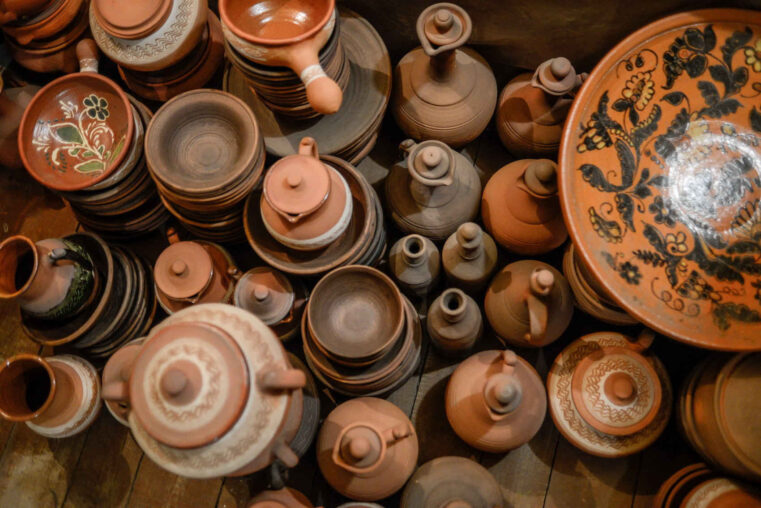The recent community call convened by Global Innovation Gathering as part of the make-a-thek project examined the relationship between heritage crafts, sustainability, and circularity across diverse contexts. The conversation centred on the work of practitioners in Ukraine and Iraq and explored the intersection of crafts with community identity, economic development, and mental health. It was hosted on July 9th by Fadia Elgharib & Kirstin Wiedow from the Global Innovation Gathering and Laura Miguel Baumann & Rachel Kelly from the European Crafts Alliance, and the invited speakers were Salih Mahmod, the former manager of Mosul Space and Natalia Viter, journalist and founder of Potter Viter studio.
Traditional building and craft methods have always been about working with what’s available, fixing rather than replacing, and creating things that last. From the historic architecture of Old Mosul to craft traditions across Europe and innovative ceramic practices in Ukraine, the panel explores the intersection of repair and traditional craft practices and how time-tested approaches offer solutions for today’s sustainability challenges.
The conversation covered:
- Balancing preservation with innovation and accessibility
- How traditional builders and craftspeople have practised sustainability for centuries
- The role of repair in preserving and reinterpreting traditional forms
- Ways that heritage crafts connect to our contemporary lives
- Circular crafting as a tool for mental and cultural recovery
The participants highlighted practical examples of how crafts contribute to local economies and knowledge systems while aligning with global sustainability discussions.
Salih Mahmod presented a detailed account of traditional architecture practices in Mosul, emphasising the material and design principles embedded in historic structures. He discussed how local materials and methods, including Islamic architectural elements, provide passive cooling and insulation suited for regional climates. Mahmod also examined the rebuilding efforts led by UNESCO and local craftspeople, which utilise recycled materials from destroyed heritage sites to restore structures while creating employment opportunities within the community.

Credit: Library of Congress / Public Domain
Natalia Viter shared her experience in Ukraine, where her pottery practice intersects with journalism and community-based work. Viter described the challenges of displacement due to ongoing conflict and how these circumstances led her to initiate projects that integrate pottery with mental health support for displaced individuals. Her projects use recycled clay and energy-efficient firing methods, aligning craft practices with ecological considerations while fostering collective healing.
The discussion explored the tension between preserving heritage crafts and adapting to modern technological and economic pressures. Participants noted that while mass-produced materials and construction methods offer affordability and convenience, they contribute to the erosion of craft-based skills within communities. The conversation identified the need for initiatives that document and transfer knowledge through training and apprenticeships, particularly in regions experiencing conflict and displacement.
Participants reflected on the role of crafts in sustaining cultural identity during periods of conflict. Viter noted that craft practices provide continuity for individuals and communities experiencing displacement, reinforcing collective identity. Mahmod emphasised that rebuilding heritage sites with traditional methods offers opportunities for post-conflict psychological healing, allowing communities to reclaim spaces that symbolise their cultural narratives.

Bottle for beverages. 1950s. Kosiv. Clay, engobe. Formation on a circle, engraving, painting, glazing
Technological tools such as virtual reality and digital documentation were discussed as means to capture craft practices for future learning while maintaining accessibility for younger generations. These tools can support the preservation of techniques and movements associated with heritage crafts while providing pathways for digital engagement. However, the participants also discussed the limitations of technology in replacing the embodied experience of working with materials.
The conversation addressed how heritage crafts intersect with circular economy principles through the use of local and recycled materials, reducing transport emissions and supporting local economies. Examples included the reconstruction of heritage sites in Mosul using salvaged stones and the use of reclaimed materials in Ukrainian pottery practices. These approaches connect crafts with sustainability practices that align with environmental objectives.
The role of crafts in mental health was highlighted, with participants noting how the tactile nature of craft practices can support community resilience and individual recovery in post-conflict and post-crisis settings. Workshops that combine crafts with music, such as Viter’s Clay Bell project, were presented as models that integrate cultural practice with psychosocial support.
The community call concluded with reflections on the need for policy and collective prioritisation to support crafts within modern economies. While participants acknowledged that not all craft practices may continue in their traditional forms, there was agreement on the importance of preserving those that contribute to community identity, ecological sustainability, and social well-being. The participants committed to ongoing discussions and collaborations to sustain and adapt heritage crafts within contemporary contexts.
🇪🇺 make-a-thek has received funding from the European Horizon Europe programme under grant agreement No. 101177660.


